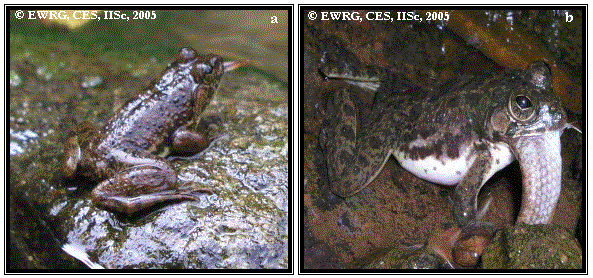
| Back | FISH EATING FROG – A CASE OF Euphlyctis cyanophlyctis (INDIAN SKIPPER FROG) (PDF) |
|
Decline of amphibian population is a worldwide phenomenon and has received great attention during recent years. Factors accounted for this decline are: ultraviolet radiation, predation, habitat modification, environmental acidity and toxicants, diseases, changes in climate or weather patterns, and interactions among these factors. It has been reported in several places that diversity of aquatic amphibian assemblages is frequently reduced in habitats containing predatory fish. Present decline in the Amphibians of the world has been related to introduction of predatory fishes into the waters (Alford and Richards, 1999).
Hypothesis that large predatory fishes are major predators of amphibians and reptiles along littoral ecotones is examined through the diets of 70 bowfin (Amia calva), 22 chain pickerel (Esox niger), 235 Florida gar (Lepisosteusplatyrinchus), 258 largemouth bass (Micropterus salmoides), and 46 warmouth (Lepomis gulosus), collected from Kissimmee River.The study showed that only six bowfin (9%) and four bass (2%) preyed upon herpetofauna, revealing a weak link between fishes and herpetofauna (Jordan and Arrington, 2001). Another study carried out on amphibian communities at 178 ponds across southwestern Ontario, Canada, to determine if presence of predatory fish was related to altered amphibian species richness or distribution on a geographic scale found that amphibian species richness was significantly lower at ponds having predatory fish present than at non-predatory, or fish-free, ponds (Hecnar and M'Closkey, 1997). The contrasting results of the two studies reveal the complex pattern of food and feeding habits of fish as well as amphibians. It can be deduced that proper matching of feeding behaviour of the fish and the type of amphibian fauna is essential for a significant feeding impact in any aquatic body. While effect of fish feeding on amphibian larvae is much debated and attributed to the global decline, there is a total deficiency in the information about amphibians feeding on fish.
During the ecological monitoring of Aghanashini River, Central Western Ghat, the most common aquatic frog Euphlyctis cyanophlyctis was seen feeding on fishes of the streams at two places, Hulidevarakodlu, (14°23'43”N 74°39'34”E, 130m asl) and Sapurthi (14°31'29”N 74°45'19”E, 440m asl) . At the former place, it was seen feeding on the fish Danio aequipinnatus (Figure a) and at the later Garra gotyla stenorhynchus (Figure b).
Euphlyctis cyanophlyctis with wider distribution (Southern Iran, Pakistan, Nepal, and eastern and southern India to Afghanistan, Sri Lanka, and Malaya; Minh Hai Province, Vietnam) is one of the most general aquatic frog (Amphibian species of the World 3.0). It is regarded as the weed species in Sri Lanka (Pethiyagoda and Manamendra-Arachchi, 1998). Detailed study of feeding behaviour of this frog as well as many other aquatic frogs can reveal several unknown realities of these aspects.
 |
|
Fig (a) : Feeding on the fish Danio aequipinnatus |
Fig (b) : Feeding on the Garra gotyla stenorhynchus |
Text |
|
Energy and Wetlands Research Group, Centre for Ecological Sciences, Indian Institute of Science, Bangalore – 560 012. Email: sreekantha@ces.iisc.ernet.in |
Photographs |
K. V. Gururaja |